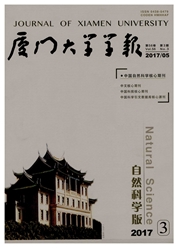

 中文摘要:
中文摘要:
于2004年9月-2005年11月通过定点逐月采样调查,研究厦门西海域微型浮游动物的丰度、生物量及其生产力的季节变动特征.结果表明:微型浮游动物群体总丰度在3310-21725ind/L间变动,于2、5和8月分别有一个峰值,对总丰度贡献较大的主要是红色中缢虫(Mesodinium rubrum)、无壳纤毛虫和砂壳纤毛虫,各类群丰度的季节变动表现出一定的差异.红色中缢虫的丰度为225~14062 ind/L,没有明显的季节性,一般在2000 ind/L以上;异养甲藻一螺旋环沟藻(Gyrodinium spirale)在0~2875 ind/L之间变动,多数月份低于300 ind/L,3月出现最大值;无壳纤毛虫在1570-8512 ind/L之间变动,全年保持着较高的丰度,于2、5和9月均可形成峰值;无节幼体和砂壳纤毛虫变动范围分别为0~1063 ind/L和162-9625 ind/L,数量变动与水温的季节变化较为密切,在水温大于20℃的5~11月,有较高的丰度.微型浮游动物生物量在10.86~111.65μg/L之间变动,由于曳尾虫(Tontonia)、螺体虫(Laboea)及砂壳纤毛虫的大量出现,生物量高值集中在相应的5~10月,5月出现最大值.微型浮游动物总生产力的变动范围为7.01~141.641.μg/(L·d),在5~10月生产力相对较高.据估算,微型浮游动物对浮游植物现存量的日摄食压力可达6%~267%.
 英文摘要:
英文摘要:
Seasonal varaitions in abundance,biomass and production rates of microzooplankton were investigated in the Stn Baozhu waters at west of Xiamen waters monthly from September 2004 to November 2005. The total abundance of microzooplankton was in the range of 3 310-21 725 ind/L, mainly composed of Mesodinium rubrum, aloricate ciliates and loricate ciliates, with the peak appearing in February, May and August. Mesodinium rubrum occurred on no distinct seasonal pattern, varied from 225 ind/L to 14 062 ind/L,generally more than 2 000 ind/L. The heterotrophic dinoflagellates(Gyrodinium spirale) varied from 0 to 2 875 ind/L,with the peak in March,generally less than 300 ind/L. Alorieate ciliates varied from 1 570 to 8 512 ind/L, having high abundance during the whole year,with the peak in February,May and September 2005. The abundance variations of nauplii and loricate eiliates closely associated to seasonal variations of the water temperature, varied from 0 ind/L to 1 063 ind/L and from 162 ind/L to 9 625 ind/L, respectively, with relative higher abundance between May and November when above 20 12 in water temperature. There was remarkable seasonal variations in biomass of microzooplankton, with the higher between May and October duo to the peak appearing of Tontonia sp. ,Laboea sp. and loricate ciliates. Estimated production rates of microzooplankton ranged from 7.01 μg/(L. d) to 141.64μg/(L. d), also with the higher between May and October. The estimating grazing impact as expressed by daily removal of phytoplankton biomass also demonstrated a seasonal pattern and ranged from 6% to 267% removal day.
 同期刊论文项目
同期刊论文项目
 同项目期刊论文
同项目期刊论文
 Comparisons of picophytoplankton abundance, size, and fluorescence between summer and winter in nort
Comparisons of picophytoplankton abundance, size, and fluorescence between summer and winter in nort Alkaline Phosphatase gene sequence and transcriptional regulation by phosphate limitation in Amphidi
Alkaline Phosphatase gene sequence and transcriptional regulation by phosphate limitation in Amphidi COMPARATIVE ALKALINE PHOSPHATASE CHARACTERISTICS OF THE ALGAL BLOOM DINOFLAGELLATES PROROCENTRUM DON
COMPARATIVE ALKALINE PHOSPHATASE CHARACTERISTICS OF THE ALGAL BLOOM DINOFLAGELLATES PROROCENTRUM DON Grazing impact of microzooplankton on phytoplankton in Xiamen Bay using pigment-specific dilution te
Grazing impact of microzooplankton on phytoplankton in Xiamen Bay using pigment-specific dilution te Phytoplankton growth and microzooplankton grazing in a subtropical coastal upwelling system in the T
Phytoplankton growth and microzooplankton grazing in a subtropical coastal upwelling system in the T 期刊信息
期刊信息
